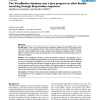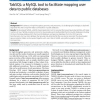CORR
2010
Springer
13 years 11 months ago
2010
Springer
Maintaining a legacy database is a difficult task especially when system documentation is poor written or even missing. Database reverse engineering is an attempt to recover high-...
CORR
2010
Springer
13 years 11 months ago
2010
Springer
In [Spi], we developed a category of databases in which the schema of a database is represented as a simplicial set. Each simplex corresponds to a table in the database. There, our...
BMCBI
2008
13 years 11 months ago
2008
Background: The ESTree database (db) is a collection of Prunus persica and Prunus dulcis EST sequences that in its current version encompasses 75,404 sequences from 3 almond and 1...
BMCBI
2008
13 years 11 months ago
2008
Background: Keyword searching through PubMed and other systems is the standard means of retrieving information from Medline. However, ad-hoc retrieval systems do not meet all of t...
BMCBI
2008
13 years 11 months ago
2008
Background: Viruses of the Bunyaviridae have segmented negative-stranded RNA genomes and several of them cause significant disease. Many partial sequences have been obtained from ...
BMCBI
2008
13 years 11 months ago
2008
Background: The zebrafish is a powerful model vertebrate amenable to high throughput in vivo genetic analyses. Examples include reverse genetic screens using morpholino knockdown,...
BMCBI
2008
13 years 11 months ago
2008
Background: Automated protein function prediction methods are needed to keep pace with high-throughput sequencing. With the existence of many programs and databases for inferring ...
BMCBI
2010
13 years 11 months ago
2010
Background: Immunoglobulin (IG or antibody) and the T-cell receptor (TR) are pivotal proteins in the immune system of higher organisms. In cancer immunotherapy, the immune respons...
BMCBI
2008
13 years 11 months ago
2008
Background: Although carbohydrates are the third major class of biological macromolecules, after proteins and DNA, there is neither a comprehensive database for carbohydrate struc...
BMCBI
2010
13 years 11 months ago
2010
Background: With advances in high-throughput genomics and proteomics, it is challenging for biologists to deal with large data files and to map their data to annotations in public...






